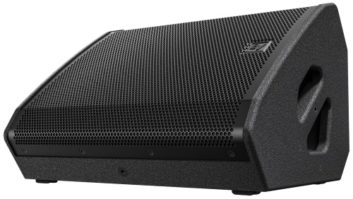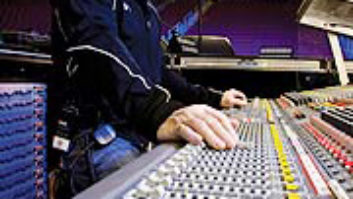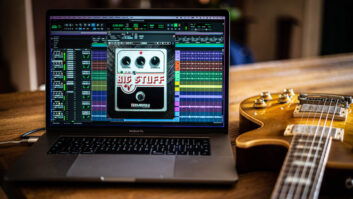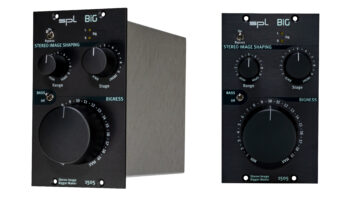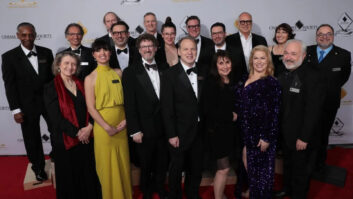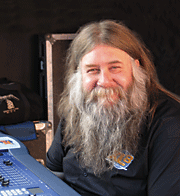
In July, Mix caught up with longtime Metallica FOH engineer “Big Mick” Hughes at London’s new Wembley Stadium. It was the seventh show of the band’s Escape from the Studio ’07 tour, a 12-show stadium run across Europe that included a concert for 70,000 fans, following their performance at the Live Earth festival the night before. The always lively Hughes talked about summer tour plans, shared some choice miking tips, and chatted about his decades on the road with the band, and getting over his fear of digital consoles—by helping design one.
LISTEN: Must Play
Managing the Hetfield growl, and balancing the in-ears/wedge combo.
LISTEN: Must Play
Capturing the Metallica “attitude”
LISTEN: Must Play
Learn Big Mick’s cymbal “underheads” trick.
So how long have you been with Metallica now?
Since November ’84, so almost 23 years. I was 25, 26. I’m now 49.
How did you hook up with them?
I already worked for the management company—I worked for a PA company in England called Texserv, with Bob Doyle. Peter Mench, who managed Metallica, and Def Leppard, and Chili Peppers, said that he wanted one of Bob’s guys to engineer this new bad he signed in England called the Armory Show. I ended up with those guys for like a year and a half; this was in ‘81, somewhere around there. Q Prime, who was the management, said, “we’re losing these guys, but we like you—do you want to do this band we just signed? It’s a new band called Metallica.” And I say, “well, what is it?” And he says, “it’s heavy metal.” I say, “what the fuck is heavy metal?” He goes, “well, you’ll find out if you do it.” And I went, “alright, then; I’ll be in for a penny, for a pound.” So I went off and we did November, December around Europe. And the band says, “we like you; do you want to be our engineer?” I said, “well what does that involve?” Because I’d never been the band’s engineer, I’ve always been the guy that came with the PA: Set the PA up, work it, put it back in the truck and leave. We started in January with Wasp and Armored Saint. And off we went, and that was January ’85, and then here we are 2007.
People say to me, you’re so fortunate to have seen the entire transition from bars to clubs to theaters to half arenas, to full arenas, to stadiums. It’s pretty bizarre to see how things changed.
Before, it was just literally the band and myself and a couple of other guys on the bus—we all went off on one bus on tour and that was it. All the trials and tribulations that I couldn’t possibly talk about that happened to 19-year old guys in bands on buses in those days. They were 19, 20, you know what I mean? And here we are, still doing it. And they’re all married with kids now.
Things have changed a lot.
Well, you know, they didn’t have two pennies to rub together in those days. They didn’t have credit cards, I remember lending them money to go and do the washing and stuff. At the very start they were in debt to all sorts of people out there. It’s a bit different now.
Tell me about this tour.
This is “Escape From the Studio.” They tend to do this when they’re doing an album. I think they get kind of bored in the studio. All the studio folks and trying to be creative and everybody going “blah blah . They just want to walk away from that occasionally, and go out and play for a few friends. They always go, ‘we’re just going to do a few small gigs.’ [laughs] We’re booking 30,000, 50,000, somewhere around there.
Sounds like some intimate gatherings.
Yeah, just a few friends around for a bit of a knock, you know?
It was quite the Live Earth lineup last night. Did you scare the Pussycat Dolls fans?
I did say to the band, look. I’m not going to crush like I would normally. It’ll be a mild crush. Because I appreciate there’s people out there who wouldn’t want to hear Metallica.
How does this new Wembley space sound?
Pretty cavernous. It’s a biiiiig place. We do these sort of stadiums in America, and I’ve had some great times in some of those. This one, I don’t know yet. I haven’t heard it with any kind of pressure. Well find out what’s happening tonight, definitely.
What’s your approach to the mix?
It’s really weird, isn’t it? Because it’s been so long. It’s 23 years of changing, honing, working out why that sounded like crap, and changing that, a bit of this, a bit of that. There are some givens, but I think that should be the case for all sound engineers.
Can you give me an example?
I do all the ambience mics first. I have six overheads; each cymbal is miked from underneath. That started a long time ago. We actually had a stage where the drum kits went down underneath. I think it was the Black album. It was two kits, and they dropped down on lifts. When they lowered the kit down on the lift, when it was all built, there was probably an inch between the hoist cymbal and the cover. So there was nowhere to put the mics over the top. And I’m like shit, what are going to do with the overheads? They’ll have to become underheads. You can’t put one on either side, so you have to mic each individual cymbal. Lars liked it because he didn’t have big cymbal stands with microphones. So we have these little AT M35 microphones that sit on little extended goosenecks, because when you put them in the middle, you have to be careful each cymbal doesn’t sound like a gong. So you extend the gooseneck a little bit so it gets you more to the edge. You get more of the stick sound.
I have triggers on the gates on the drums. I don’t use the triggers to trigger sample sounds, I just use the triggers to open the noise gate, because there’s so much noise on the stage that you constantly get the gates on the toms—“psst, psst, psst”—so to get rid of that I’ve got a trigger taped to the shell, comes down the multicore, and plugs into the gate at front of house, and makes it open the gate on vibration as opposed to acoustics. So you can just tap the rim on the drum and the gate will open, but you can fire the loudest speaker at the microphone and nothing happens.
That’s a good trick…
Over the years, I used to gate subs and control the gate with the kick drum-and all you do is drop, say, 3 dB on the subs with the range-just allow everything up to 3dB to go through, and as the kick drum hits, it puts the gate wide open, you get an extra 3dB burst of low end through the subs, a little bit more bass guitar, a little bit more guitar, a little bit more of everything, and you can get an even bigger kick drum.
Lots of things like that I’ve tried over the years. But you know, you try things for certain tours, certain PAs, and then time goes on and next time you go, “oh, I’m not going to bother with that this time,” or, “this is a powerful PA, I don’t need to do that.” You just hone and keep changing. Simplicity though, I’ve always found to be the best approach.
I would imagine they have a pretty straightforward sound.
It’s a rock band, at the end of the day. They make a lot of noise. I actually did Def Leppard as well, and Ozzy, and Slipknot. The harder bands like this are harder to do…You’ve got Def Leppard, who’s fantastic; if there’s a solo going on, everybody calms down and shuts up. But these guys, there’s a solo and they all play harder. There’s no, “oh, he’s doing a solo, let’s back off, go ahead to the front.” So it’s not quite as easy as you think; there’s a lot of juggling.
So you’re riding the volume over all of that?
Oh I have to mix it constantly. But I’m also trying to capture an attitude; it’s not just the sound. It’s Metallica, it has its own attitude, they created a type of sound in the beginning and we honed it together—you know, click on the kick drum, nobody was ever putting click in the kick drum, I started doing that for the simple reason you couldn’t fucking hear them. We’ve always worked around those things; of course I used to spend a lot of time with the band, and we talked about stuff. It’s funny now, because we haven’t talked about sound for many years.
You guys are like family.
Yeah, you know, what are they going to say to me after 23 years? Inherently, if it’s not sounding good, they’ll know I’m trying my hardest to sort it out. And when it’s right, then we’re all roaring together.
What is James singing into?
ATM 5400s. They’re all AudioTechnica mics-2500s on guitars, 5400s on vocals, ATM35s on toms and “under heads,” 23s on top of the snare, 451 on the bottom, 451 on the hi hat.
So are you doing anything with his vocal channel?
James has a really powerful voice and a hugely dynamic mic technique. In the midrange-he makes a lot of 630 Hz. So once you’ve chunked that out and tweaked a few other eq points, then he sounds fine. I also use an RMS averaging compressor (the adaptive compressor on the XL8) at about 3:1 with a moderate attack and a gain reduction of about 6db. This smooth’s out the dynamics a little but still allows the performance to shine through.
Is the whole band on in-ears?
In-ears and wedges. Most bands, when you get in-ears, you get rid of the monitor speaker system. Metallica never get rid of anything, they just add. James’ statement was great: He said, “We need wedges.” I said, “why?” He goes, “for guitar feedback. I can’t hold the guitar up to my ear!”
We don’t really have much backline onstage, it’s all in isolation chambers, flight cases with the mics built in, and they’re parked in the back, on the trucks-the guitar sound. It doesn’t actually come from the stage, it comes from somewhere else. So we can’t go up to that because it’s sealed. There are a couple of cabinets onstage.
So how many inputs are you working with?
Total number of input channels from the stage is 48, including six triggers. There’s “pyro playback,” there’s the VT playback, so I think it’s like 38 channels of band. Amongst that are 10 vocals, there’s four channels on James’ rhythm sound. There’s two channels on Kirk’s sound and there’s another 2 channels on James’ clean sound. There’s 2 channels of bass, six overheads, 4 tom toms. 2 kicks and three snare. That’s your lot. And a hi hat.
You’re a longtime fan of Midas boards. How did you get involved in development of the XL8?
I did 11 years of XL4; I bought my own desk, it was lovely. But they can’t make them anymore [due to Europe’s Reduction of Hazardous Substances initiative]. And to be honest with you, there are no other new big analog boards about, and I thought, well, it’s probably time to step into the 21st century and take a walk on the digital side. I had a couple of boards at home to play with, and didn’t like the sound, didn’t like the way they felt. So I thought, I’d better get involved in making one.
What did you want out of the console?
Something I could use. The ergonomics of it, the feel of quality like the XL4. I also wanted to remove the scary bit about getting sound out of it, because some of these things, it’s like you’ve got to play Battleship with them to get the sound in or out.
So the Midas team was already designing the board when you came in?
Oh yeah. [Midas XL4 designer] Alex Cooper sat there for six months plus, listening to a wood block amongst other things. He had an XL4 eq and other eq’s for comparison and he modeled the new XL8 EQ in the analog world. Then the digital boys came in and turned these analog plots into digital, and then it was stuck together with Leggo bricks and bits of wire for him to do further listening. I sat there with him a few times and it’s pretty soul destroying, actually, to sit there and listen to a wood block go dik dik for 12 hours a day. [laughs]
And then I’d come in and say, “why does it do that? You should press this button and touch these and it should all work,” and they all go, “that’s 150,000 lines of code to sort through…”
…and they’re not making the board just for you.
Yeah, yeah, I just have to back off sometimes and realize that they have other agendas afoot, not just mine. So we’ve pulled and pushed, and they’ve accommodated me as much as they could. It’s made a fantastic console. it brings channels to you; you don’t have to go to channels anymore.
So you’ve spent literally half your life with Metallica. What kind of effect does that have on you?
Drive you insane. [Laughs]
